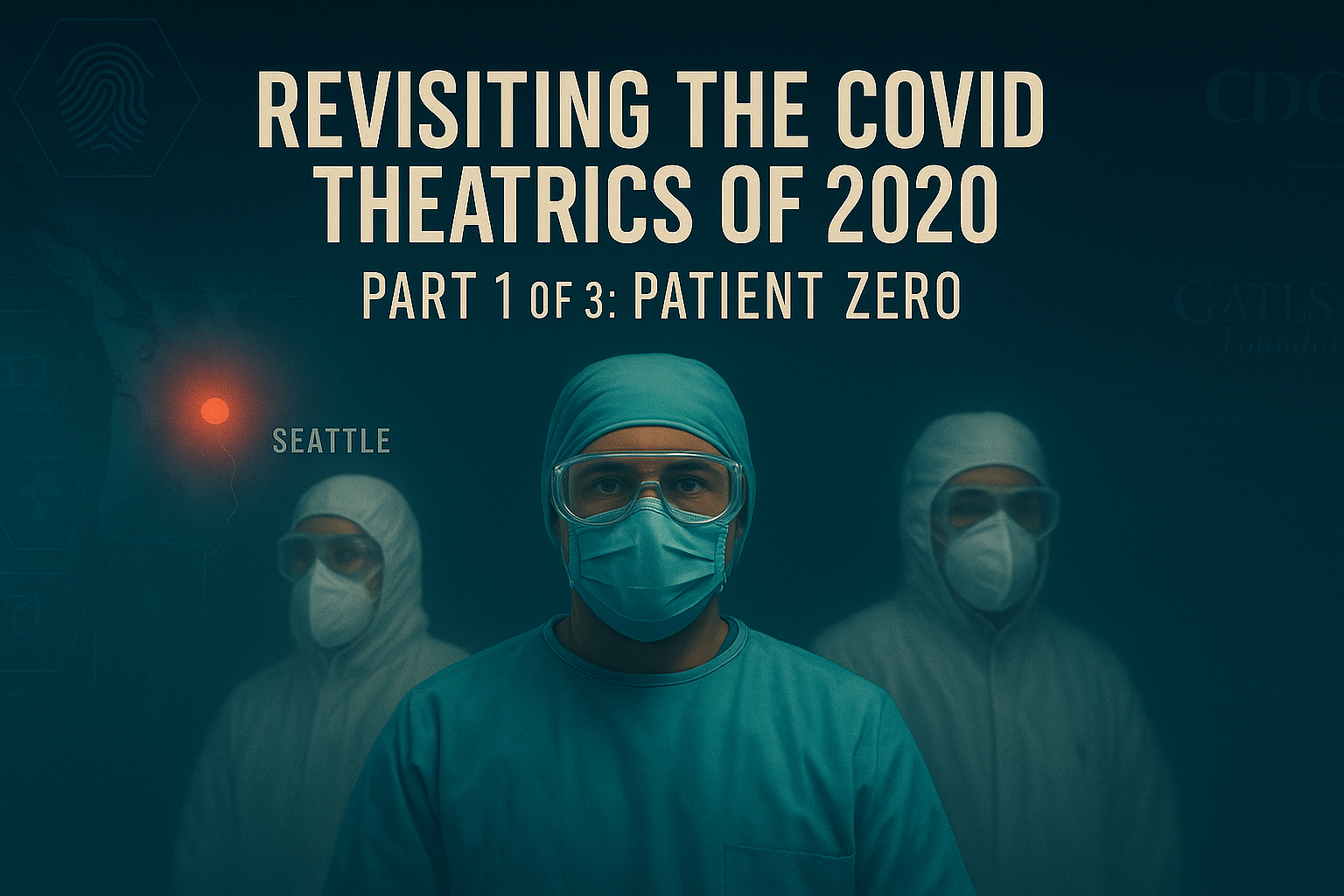
Who were they? Where are they now? Was it even real?
Looking back on the covid spectacle we remember its innumerable anomalies, its bizarre stagecraft, and its strange characters—all situated in the center of a declared global emergency.
Most of these oddities have yet to be explained, leaving many to wonder if the events can be believed.
Three in particular stand out: "Patient Zero," which we will study in Part 1 (below); “A Man Falls Dead on the Streets of Wuhan,” which we will study in Part 2; and “The Dancing Nurses,” our topic in Part 3.
PART ONE: "Patient Zero"
According to early media reports, a deadly coronavirus came to the United States in January of 2020. It made its first landing just north of Seattle, Washington, in Snohomish County. An individual who would become known as “Snohomish Man” (or S-Man, for short) was identified as a confirmed “COVID-19 case” on January 22, 2020. The media would claim that this was the first confirmed case of a mysterious respiratory infection in the US.
S-Man was identified as a 35-year-old Chinese-born legal permanent resident of America who lived alone. He traveled to “his original home” in Wuhan, China, in November 2019. The details of his activities while in Wuhan have never been released. It has been posited that he was visiting family, but it has also been suggested that he was there for work.
Allegedly S-Man returned to the US from China on January 15, 2020. Four days later, after a physician's consultation, he was sent to the Providence Regional urgent care clinic in Snohomish County. The Providence Medical Center happened to have a special pathogens unit in which S-Man was placed. This was at the very time that the US Centers for Disease Control and Prevention was warning against alarmism and assuring us that "the risk to the American public” of being infected with this mysterious virus “is low."
S-Man’s illness upon admission was described as:
A "persistent dry cough”
A “two-day history of nausea and vomiting”
“No shortness of breath or chest pain”
“Vital signs within normal ranges”
“Dry mucous membranes” (per the initial physical exam)
“The remainder of the examination was generally unremarkable." [Emphasis added.]
In other words, S-Man was not hospitalized because of abnormal symptoms or because ill health compelled it, but only for observation.
Despite arriving at the hospital in this “unremarkable” condition, S-Man was taken in an “isolation pod” directly to a special pathogens unit. It was the first time that this special room—set up during the Ebola crisis of 2014-to-2016—was used in a “real-life” scenario.
In May 2021, sixteen months after S-Man’s original physician’s visit led to this chain of events, further details about his case emerged when physician assistant Keith Erickson agreed to tell his story to WORLD, a monthly Christian magazine. Up until that point, Erickson had been anonymous.
According to Erickson, he thought he was attending to just another flu patient. He learned of the “outbreak” only after checking the CDC website, where he “found a bulletin urging health officials to be on the lookout for patients matching three criteria: travel from China, fever, and respiratory illness.”
After alerting the Washington State Health Department about his patient, Erickson received a call from someone who identified herself as the head of epidemiology at the CDC.
Erickson told WORLD that, after a five-hour barrage of phone calls and inquiries during which the patient sat in the exam room, CDC officials decided among themselves that S-Man might be the first patient in the US—"Patient Zero”—to have contracted this new virus.
Does anyone find it strange that even though word of the supposed virus was spreading around the world—and certainly throughout the medical community—Erickson was oblivious to the new pathogen? And is it also strange that, despite being unaware of it, he checked the CDC website? Why would he have taken such an unusual step?
Erickson collected patient samples and over-nighted them to Atlanta, home of the CDC.
The rest is history.
To date, “Snohomish Man” aka "Patient Zero" has never been identified. Several retrospective pieces have challenged his existence and questioned whether he is the real "Patient Zero.” The first and last we heard from the mystery man himself was in early February 2020, when he released the following statement:
“I am at home and continuing to get better. I ask that the media please respect my privacy and my desire not to be in the public eye. I would like to thank the doctors, nurses, and entire team at Providence who cared for me. I appreciate all of the concern expressed by members of the public, and I look forward to returning to my normal life.”
It was reported that of the sixteen people who had come in contact with S-Man, none developed symptoms that might have been attributable to this allegedly highly contagious pathogen.
Consider the can of worms that might be opened if an intrepid reporter were to ask a few basic questions:
1. Where is S-Man now? What is his “normal” life like?
2. How did S-Man manage to disappear into the wilds of Washington State, never to be identified or interviewed?
3. Does anyone dare ask if Snohomish Man ever existed or if he was a made-up case?
And those questions barely scratch the surface.
CODA
The story of “Patient Zero” is not complete without recognizing the importance of the geographic location in which it took place.
It is also incomplete without an examination of other related events of early 2020 that occurred in the same region.
Seattle, Washington, is located in King County. King County is where Microsoft’s world headquarters is located—in Redmond, to be precise. Directly north of King County lies Snohomish County.
In the US, the first "covid death" was alleged to have occurred at EvergreenHealth Medical Center-Kirkland in Kirkland, Washington, a Seattle suburb that is also located in King County.
Interestingly, the first health care worker said to be infected with the disease (in February 2020) and the first “outbreak” in a long-term care facility (in February 2020) were both said to have occurred in Seattle.
Equally interestingly, on March 6, 2020, the University of Washington in Seattle became the first university in the US to announce that classes would move to remote instruction in an effort to "slow the spread of the novel coronavirus."
Notably, the University of Washington in Seattle is the biggest beneficiary of Gates Foundation funding among all higher education institutions in the US. Between 2010 and 2019, UW received more than $1.56 billion from the Gates Foundation. That sum accounted for 13% of the Gates Foundation’s giving to higher education institutions during that time frame.
Skip another ten days to March 16, 2020, when the first experimental covid vaccine doses in the US were given at Kaiser Permanente Washington Research Institute in Seattle—also, not surprisingly, funded by the Gates Foundation.
And so it goes that the area of the country where the seeds of the “covid story” were planted—the first “covid patient,” the first “covid death,” the first health care worker infected, the first “covid outbreak,” and the first university closure—is the same region where academia, industry, and the media are heavily financed and influenced by the Gates Foundation, an institution that stands to profit immensely from that story.
Mere coincidence?
Click here for the next part in this series: Revisiting the Covid Theatrics of 2020 - Part Two: A Man Falls Dead on the Streets of Wuhan














